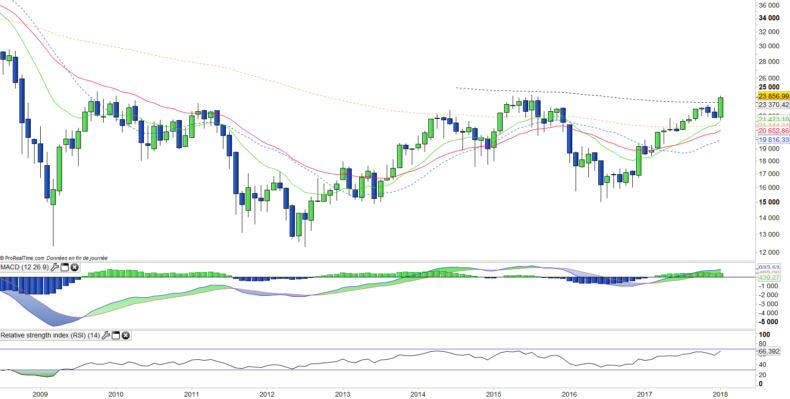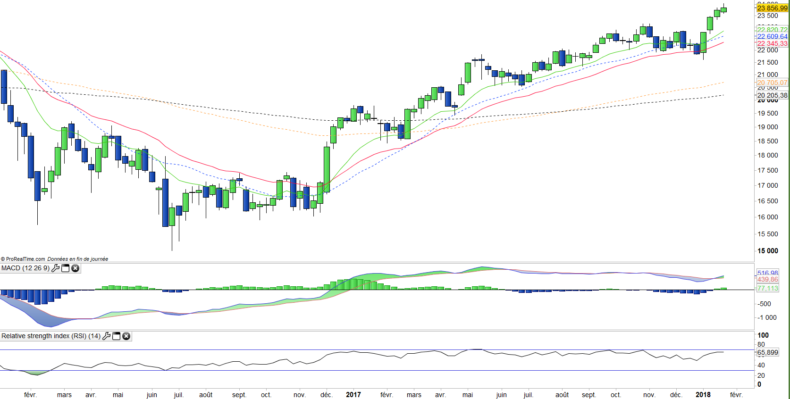Lyxor ETF FTSE MIB - MIB - 29/01/2018
Short Term strategy : Positive (100%) / trend +
Long Term strategy : Positive (100%) / trend +
Characteristics of the ETF
The ETF MIB (Lyxor FTSE MIB40) created in 11/2003, listed in Euro on Euronext, replicates the Italian national index, composed of the 40 main Italian securities.
The composition of the index is determined on the basis of three criteria: free float, liquidity and the representativeness of the main sectors of the Italian market.
The ETF MIB charges are 0.35%, and the AUM is approximately € 706M. Replication is indirect (via swap) and there is a dividend distribution policy.
Alternative ETFS: EWI (iShares USD), IMIB (iShares in Euro)
Index & components
This index has the particularity of being very overweight in financials which represent more than one third (38.1%) of its composition (against about 20% for the stoxx600), including Intesa San Paolo, Unicredit and Generali while the energy is also a significant weight (15.1%) via ENI and Saipem, the other important sectors are cyclical consumer goods (15%) and utilities (14.1%), among which are Enel , SNAM and Atlantia. The 10 largest caps represent just over two-thirds of the index (67.9%).
The Italian index is very volatile, given the importance of cyclical and financial sectors and the structural weakness of the Italian economy due to lack of growth, high unemployment and huge debt (130% of GDP) which worries the markets regularly.
The Italian economy has been hit hard by the financial crisis: it has contracted by more than 9% since 2007 and has faced 13 quarters of recession. Although the Italian economy has emerged from the recession since 2015, growth remains below the Italian government expectations and the euro area average. In 2016 the country was hit by two earthquakes and the arrival of 170,000 migrants on its territory which led to a major humanitarian crisis. Italy made good progress in its banking restructuring in 2017 with the rescue of state-owned banks and the takeover of assets by Intesa Sanpaolo, which followed the rescue of BMPS, as well as the refinancing of Unicredit for 13bn€ in the first quarter of 2017.
Overall, the structural factors (banking system reforms and labor flexibility) are taking shape, and the business cycle is accelerating. The Euro / USD exchange rate remains a significant factor for the Italian economy driven by exports. The elections of March 4 may have a significant influence on the Italian economy and the index, especially in case of political blockage.
Latest developments
In 2017, the index posted an increase of 13.6% (against 10.6% for the stoxx600NR) and is already growing by 9.2% in 2018.
The banks have been supporting the index since the beginning of the year (+14 % for ISP and + 15% for Unicredit) while the energy sector rebounded strongly with ENI (+ 8% since the beginning of the year) and Saipem (+ 6%). Italy's GDP is expected to have increased by + 1.6% in 2017, it is expected at + 1.4% in 2018 and is estimated at + 1.1% in 2019.
Although improving, Italian growth remains below the European average, which is due to the high level of indebtedness (130% of GDP) and unemployment which remains at a high level, but slightly decreases: over one year, the number of job creations has reached 345,000 people and the number of people in employment reached 23.2 million, the maximum reached since these statistics existed in 1977. The Italian government forecasts an unemployment rate of 11.5% in 2017, after 11.7% in 2016.
Elections of March 4 are key to the continuation of this trend, the left-wing M5S populist party and the coalition of center-left parties led by Mr Renzi are currently tied in the polls with a ten points on the right-wing coalition led by party candidate Silvio Berlusconi conservative Iberian Forza Italia (FI), in which are also present the two eurosceptic parties on the right.
Monthly data
The monthly chart shows a long-term uptrend that is sharply stronger with the formation of a large white positive candlestick in January driven by the rebound in the banking sector. The oscillators are positive without there being a state of overbought characterized. The prices are now coming to the major resistance of 24000 pts on which the index has been stumbling for 9 years. Its crossing would signal the beginning of a new era, with a strengthened long-term uptrend.
Weekly data
On the weekly chart, we can see a fairly strong upward momentum since the beginning of the year. This movement arrives on a significant resistance which should slow down the movement for some time. The work of the resistance should continue in the coming weeks, and could last until the of 4 March election. The prices should, in the meanwhile, remain in contact with the very strong resistance before the crossing takes place.
ETF Objective
MIB is a UCITS ETF which replicates the FTSE MIB Net TR (40 italian companies)
Characteristics
| Inception date | 04/11/2003 |
| Expense ratio | 0,35% |
| Benchmark | Indice FTSE MIB |
| Ticker | MIB |
| ISIN | FR0010010827 |
| UCITS | Yes |
| EU-SD status | Out of scope |
| Currency | € |
| Exchange | Euronext Paris |
| PEA (France) | Yes |
| SRD (France) | Yes |
| Dividend | Distribution |
| Assets Under Management | 706 M€ |
| Currency Risk | No |
| Number of Holdings | 40 |
| Global Risk | 4/5 |
Country breakdown
| Italy | 86% |
| United Kingdom | 9% |
| Netherlands | 3% |
| Luxembourg | 2% |
Répartition sectorielle
| Finance | 38% |
| Energie | 15% |
| Bien de consommation cyclique | 15% |
| Service aux collectivités | 14% |
| Industrie | 10% |
| Technologies de l'information | 3% |
| Services de télécommunication | 2% |
| Autres | 2% |
Top Ten Holdings
| Intesa Sanpaolo | 11% |
| Unicredit | 11% |
| Enel | 11% |
| ENI | 10% |
| Assicurazioni Generali | 6% |
| Fiat Chrysler | 6% |
| Atlantia | 4% |
| Ferrari | 3% |
| STMicroelectronics | 3% |
| CNH Industrial | 3% |


